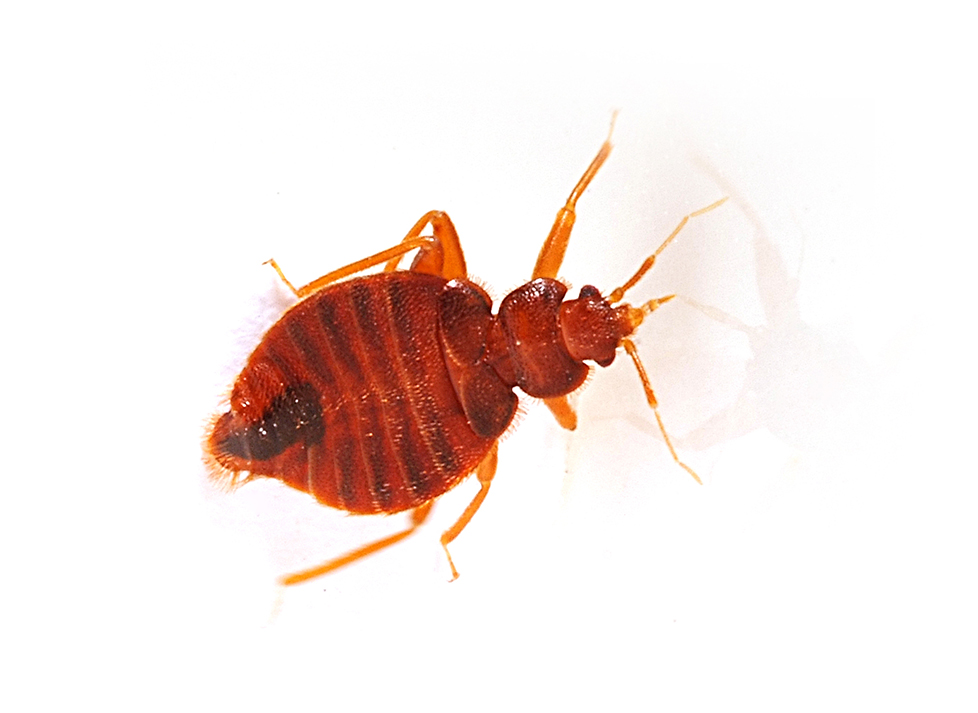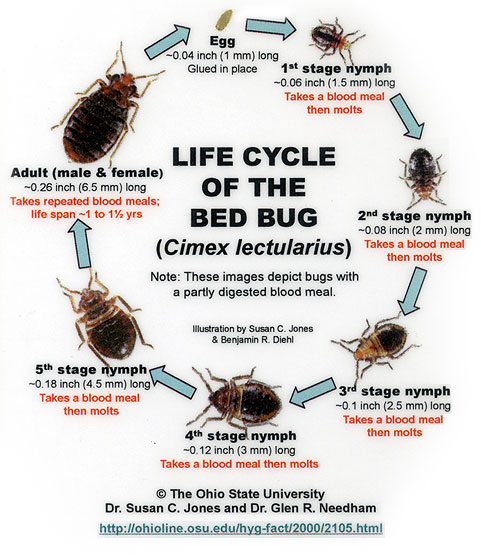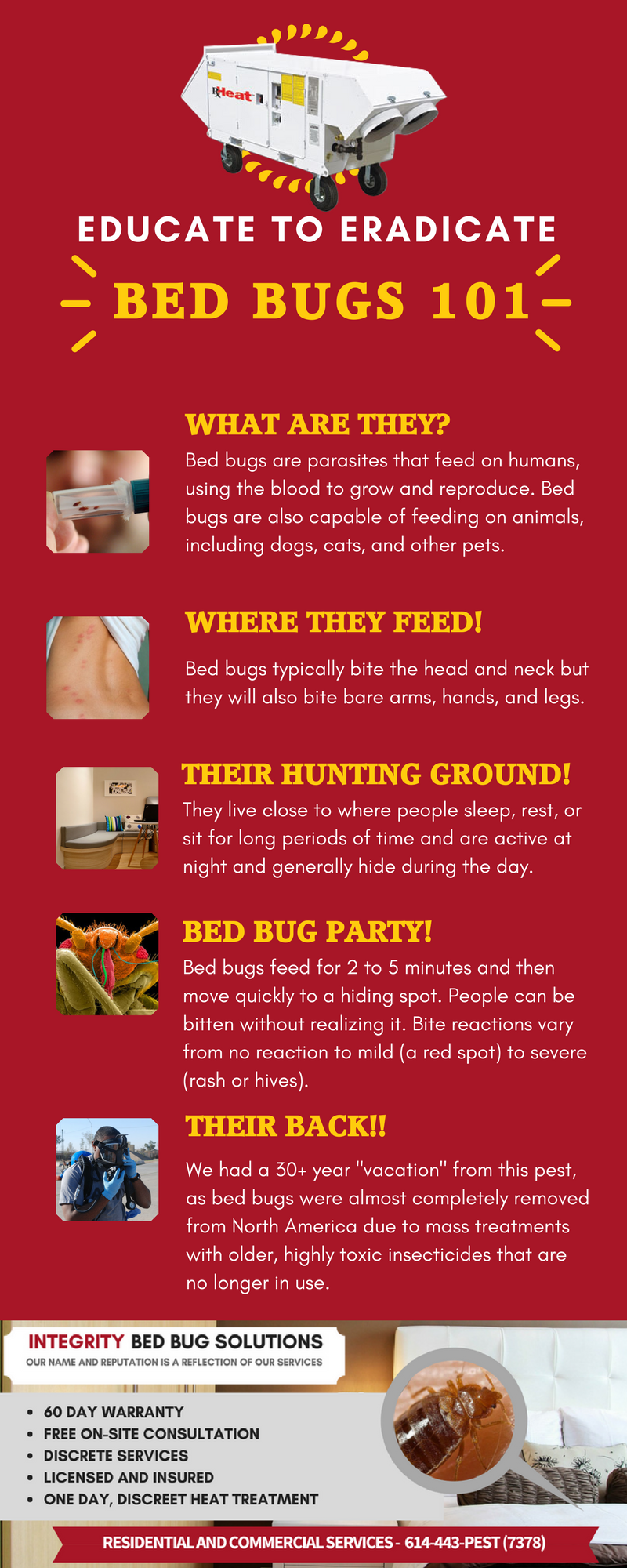614-443-7378
ART@OHIOGOTBUGS.COM
Bed Bugs 101
- Home
- Bed Bugs 101
INTRODUCING CIMEX LECTULARIUS
Bed bugs are little pests that can add up to be a big problem, but be assured there is nothing to fear from these insects. Education is a potent antidote to fear. This page of facts and information is meant to lead to a greater understanding of these six-legged nuisances.

Cimex Lectularius, more commonly known as bed bugs, are nocturnal parasites that feed on the blood of any warm-blooded animals, but prefer humans. Female bed bugs can lay up to 500 eggs in her life causing an alarming growth in infestations by 500% since 2007. They can travel more than 100 feet but tend to stay close to their food source. Hiding in folds & creases of linens, in and under mattresses, drawers, nightstands, electronics, outlets, base moldings, and draperies. Rich, poor, clean, dirty, everyone is susceptible to this infestation. They can be found virtually anywhere; in private homes, nursing homes, hotels, many apartments and condos. Reports indicate there is no place beyond their reach, including offices and schools. If you’ve found bed bugs in your home, Integrity Pest Solutions will eliminate them today.
Life Cycle
THE 7 STAGES
Female bed bugs can lay anywhere from one to twelve eggs per day, and the eggs can be deposited on rough surfaces or in between cracks and crevices. The eggs are coated with a sticky substance so they can adhere to the substrate. Eggs tend to hatch in 6 to 17 days, and nymphs can immediately begin to feed. They require a blood meal in order to molt. Bed bugs reach maturity after five molts. Developmental time (egg to adult) is greatly affected by temperature and takes about 21 days at 86° F to 120 days at 65° F. The nymphal period is greatly prolonged when food is scarce. Nymphs and adults can live for several months without food. The adult’s lifespan may encompass 12-18 months. Three or more generations can occur each year.
Source: OSU Entomology Fact Sheet – Susan C. Jones, Ph.D., Assistant Professor of Entomology Extension Specialist, Household & Structural Pests

BED BUGS AND HUMAN HEALTH
BY CHRISTOPHER EDDY, MPH, REHS, RD, AND SUSAN C JONES, PHD

Bed bugs are small parasitic insects that feed solely on blood, preferably human blood. Bed bugs typically feed when their host is asleep, biting the host’s exposed areas such as the face, neck, arms, and legs. After piercing the host’s exposed skin, the bug injects a salivary fluid containing an anticoagulant that helps it obtain blood. The bite itself is relatively painless, but the injected salivary fluid is responsible for considerable localized and, occasionally, systemic reactions, although individuals differ in their sensitivity. The majority of humans (70%) have allergic reactions to bed bug bites and experience inflamed swollen welts and itching, sometimes very intense, that last for hours to days. Scratching can cause the welts to become infected due to secondary bacterial agents, which may result in eczematoid dermatitis, cellulitis, impetigo, and pyoderma. Severe bed bug infestations can initiate iron-deficiency anemia due to significant blood loss. Systemic reactions from bed bug bites occasionally are reported. These include asthma, generalized urticaria, and anaphylaxis. For example, bed bug infestations are associated with airborne allergens that may produce bronchial asthma. Furthermore, a variety of physiological and psychological responses often is experienced by those dealing with bed bug infestations. Anxiety, stress, insomnia, and depression are common responses to bed bug infestations, and such medically important symptoms can lead to other health conditions. In fact, routine exposure to bed bug bites may make a person more susceptible to common diseases.
Frequent bed bug bites have resulted in “sensitivity syndrome,” which is characterized by nervousness, jumpiness, and sleeplessness. Feelings of social stigmatization, anger, frustration, paranoia, embarrassment, and devastation also are reported by those living with bed bugs. With such an array of health effects caused by bed bugs, how can any local public health jurisdiction justify an indifference to the plight of bed bug victims?
Bed bugs were officially designated as a public health pest in Pesticide Registration Notice 2002, which was jointly issued by the U.S. Environmental Protection Agency (U.S. EPA) and the Centers for Disease Control and Prevention (CDC). In August 2010, these federal agencies issued a joint statement declaring bed bugs to be “a pest of significant public health importance.” The reemergence of bed bugs throughout the world poses a new challenge in modern public health since these small blood-feeding insects closely interact with humans and now are recognized at the federal level as an important environmental and public health issue.
The above is an excerpt from Bed Bugs, Public Health, and Social Justice: Part 1, a Call to Action
by Christopher Eddy, MPH, rEHS, rS and Susan C. Jones, PhD.
DON’T WAIT, CONTACT US TODAY!
